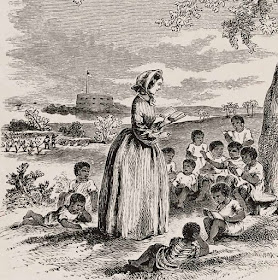South Carolina school teacher with the shadow of
Fort Sumter in the background.
Union troops marching into Beaufort, South Carolina, the town on Port Royal.
Residents at the Old Fort Plantation
The photographs from the Library of Congress
One 1863 estimate of the population of freedpeople on Port Royal was about 9,000. The nominally free people were legally freed on January 1, 1863 with the Emancipation Proclamation when a ceremony was held at the Old Fort Plantation to read the text to a joyous audience.
Old Fort or Smith Plantation residents
The 1860 census listed 131 slaves on the cotton plantation.
Here she explains why she used the term contraband
in her title.
Elizabeth was a practical woman, a fan of "needles and thread and soap and decent clothing" as the "best educators" of people who'd been kept in degrading conditions for generations. At first, supplies were hard to find.
"There was some coarse, heavy contraband goods [osnaburg, jeans cloth or other fabric for slave clothing] stored in the arsenal. Could I make use of it in my school ? I replied, we could use anything that could be cut with scissors and pierced with a needle;. So he donated several pieces of dark hickory-brown twilled cotton.
Something that looked like this?
"One of the 'Disciples' in Boston had already furnished me with a generous supply of threads, needles, thimbles, etc...."
Sewing classes were a treat for everyone.
"The chief amusement of the girls was to sing and to sew on their patchwork. Sewing was the most fascinating of all, in which the mothers deeply sympathized. The only thing all the women would beg for was 'scraps for quilts.' "One girl wanted work to take home.
"If Miss Noy only gave me sewing at home, I'd make one big quilt before this month was done."
The Old Fort plantation, formerly owned by John Joyner Smith, was where Elizabeth settled and had a school built. She brought two of her nieces with her to the Whitney School, named for the New Englanders who funded the project, perhaps this building recorded by Hubbard & Mix, photographers from the town of Beaufort.
Miss Botume standing on the porch?
Another Hubbard & Mix photo of the teachers at Smith's Plantation,
likely Elizabeth (left) and her sister's daughter Frances Sophia
Langford Haseltine (1842-1887)
Sisters Fannie & Lizzie
from Find-A-Grave
Elizabeth "Lizzie" Botume Langford Lombard (1846-1928 )
also accompanied Aunt Elizabeth to Port Royal.
The girls' mother had died in 1864.
A note to the newspaper The Freedmen's Record
The Freedmen's Record published a list of teachers in 1865
Croquet Party, Old Fort Plantation
Other teachers and students are pictured in this shot of the Smith Plantation photographed by E.W. Sinclair. Library of Congress.
"To each girl a needle, to each woman a needle and a 'hank' of thread.... But the boys begged for one needle too which I gave, to their infinite delight."
The boys objected to the girls' privileges:
Students at the nearby Penn School, photo by Hubbard & Mix.
What IS that woman in the back row holding?
Links:
First Days Amongst the Contrabands by Elizabeth Hyde Botumehttps://babel.hathitrust.org/cgi/pt?id=nc01.ark:/13960/t5cc2k499&view=1up&seq=5&skin=2021
And a post on quilts at another school.

























Part of me thinks she's holding a dress with the front neckline facing the camera. Another part of me thinks she's holding a baby in a cloth, with her hand shading its eyes.
ReplyDeleteJustGail---picture is vague. I thought of a garment. Baby is also a good guess in a blanket.
ReplyDelete